By Manish Puri
Imagine a Venn diagram with three rings representing quality cloth, construction and design.
If you buy an item of clothing that sits in one of those rings you’re still doing better than half the landfill-peddled-as-fashion you’ll find on the average UK high street.
If you buy something that lies in the union of two of them, you’ve made a savvy purchase. But, chances are that you’re informed enough to be aware of the missing dimension – and it’ll niggle at you. (“I love the cloth and design, but it’s starting to fall apart”, or, “My tailor made a flawless, entirely handmade suit, but I picked an impractical cloth.”)
It’s in the intersection of that trio – that small landing strip – where you’ll find permanent style (both lower-case and capitalised). And, in my eyes, the subject of today’s guide – the casual chambray shirt, which, in essence, means those inspired by American work shirts – is as perfect an embodiment of those three principles as any article of clothing I can think of.
Let’s start with the cloth. Chambray’s origins go back to the 1500s, in the Cambrai region of north-eastern France, where a lightweight plain-weave fabric was woven (initially in linen) to make shirts, handkerchiefs and delicate pieces like lace.
Eventually, that plain weave evolved into one with a coloured warp (usually blue) and a white weft – the defining feature of chambray (above).
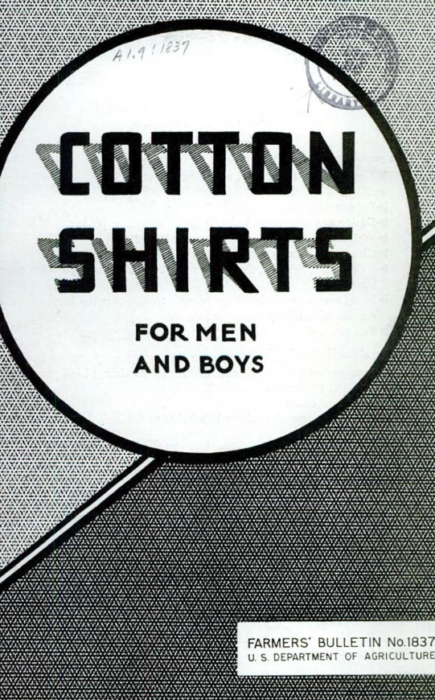
Over the years, chambray became the de facto material for work shirts – it’s where the term “blue collar” originates from.
In 1935, Margaret Smith, a home economics specialist, summarised the fabric’s suitability for workwear in issue no. 1837 of US Farmers’ Bulletin (above – an incredibly helpful and still remarkably current resource to help consumers determine quality):
“For outdoor work in mild weather, choose a material such as chambray, which is durable, firm enough to prevent sunburn, yet lightweight enough [to] admit air and be fairly cool.”
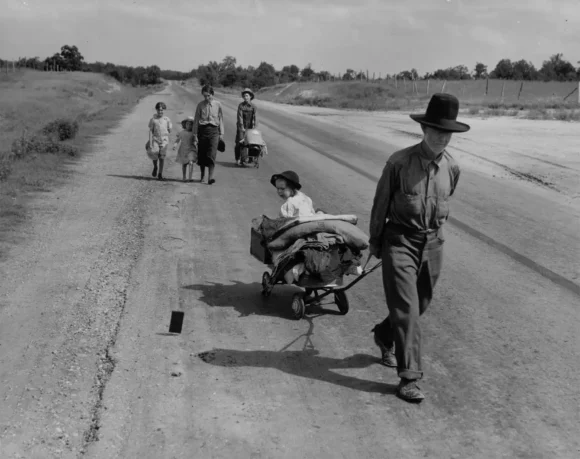
Cloth alone wasn’t enough to fortify the shirts against the rigours of manual labour, however. From mining to laying railroad to building skyscrapers, this was the uniform of the people that built a nation.
So these shirts, by modern standards, were extraordinarily well-constructed. Double and sometimes triple-stitched seams, bar tacks on stress points, and extra-strong buttons were typical features – and you’ll see many of them replicated on the shirts in this guide too.
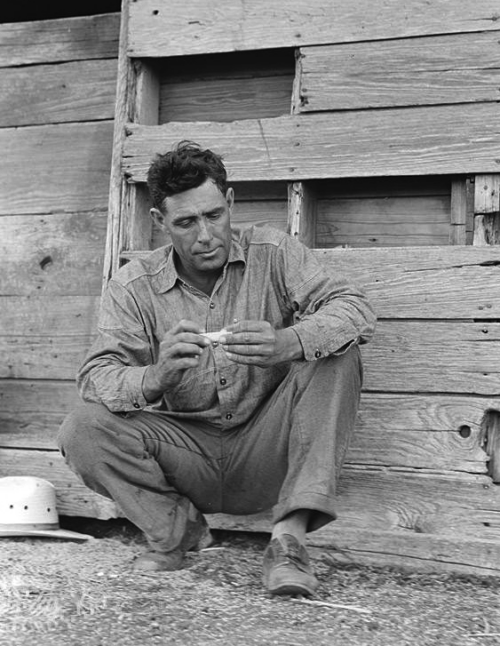
And, finally, what of design? I mean, a suit of armour is durable and well-constructed too, but nobody wants to sit at a laptop wearing one.
The shirts were cut generously through the body so they wouldn’t cling to sweat, full in the sleeve so there was no encumbrance to range of motion, long in the tails so they stayed tucked in, and with pockets that were ingeniously designed and truly functional (rather than the affected signifiers of casualness that are are often stitched onto a top these days).
In short, each new design or advancement was brought about to make the shirt more durable and less obtrusive. It was a workwear manifestation of that oft-quoted Hardy Amies aphorism, “a man should look as if he had bought his clothes with intelligence, put them on with care and then forgotten all about them.”
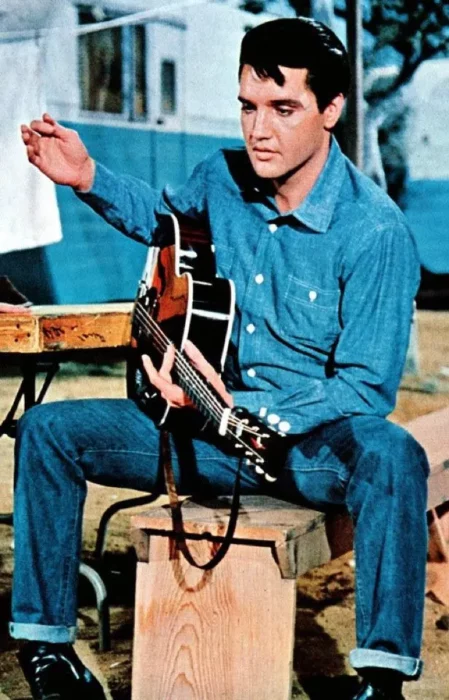
This guide is very deliberately focused on casual shirts and work shirts: those with chest pockets, contrast stitching, roomier cuts and softer, smaller point collars.
The collar is often a barometer of how successfully a shirt works with tailoring. The softer and smaller it is, the likelier the prospect of it slipping under the jacket and not framing your face in the same way as a dressier shirt (like the PS Selvedge Chambray). How much this matters will really depend on personal factors such as the length of your neck, or how you like to present yourself when wearing tailoring.
My fellow PS columnist André (below) excels at wearing soft-collar (and even collar-less) shirts with tailoring and jacket alternatives. Perhaps the key is undoing an extra shirt button just to reintroduce the length that’s lost by not having a higher and larger collar. Whatever the secret, even if his collar slides under a lapel, it always seems a natural and harmonious style choice for André given how easygoing his look is.
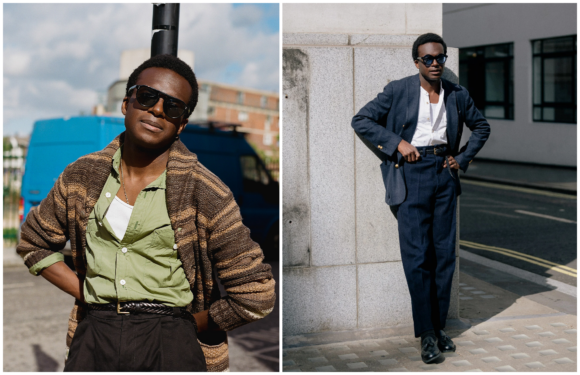
In the first part of this guide, I’ve reviewed a few shirts that are explicit reproductions of US work shirt models, as I think this is also a good way of diving into some of the design and construction points I touched upon in the introduction. In the UK, these shirts (and many kindred designs) are available at shops like Son of a Stag and Clutch Cafe. For international readers, you’ll find them at similar denim and workwear shops.
In the second part, we’ll look at shirts made by brands that are less focused on strict reproduction. These shirts, whilst still heavily influenced by American models, have modifications such as a shorter length, a pocket removed, different collars, waist taken in, etc – which can make them more contemporary, versatile, and easier to pair with tailoring.
Unfortunately, there will still be plenty of quality shirt options that aren’t covered in this guide: Full Count and Real McCoy’s are two that come to mind immediately. I’ve had to draw the line somewhere but, as always, your experiences and recommendations are welcome and valued in the comments section.
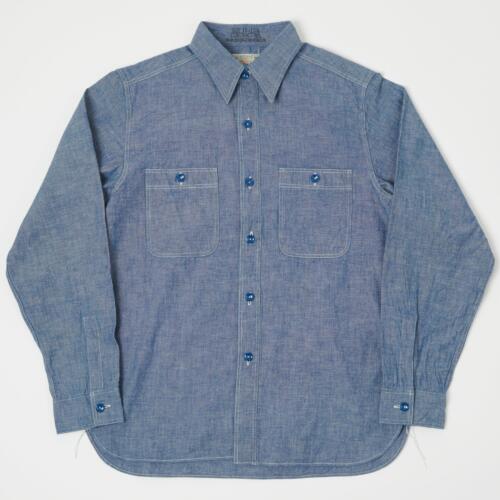
Buzz Rickson’s USN Chambray Blue Work Shirt – £129
My first port of call when researching this guide was my local denim shop – the excellent Son of a Stag in east London – which carries a healthy range of chambray shirts in various weights, colours and styles.
I was keen to know which one the staff recommended, and was pleased that, on the basis of detail, quality and value-for-money, they opted for the Buzz Rickson USN chambray, because that’s the one I liked the look of too.
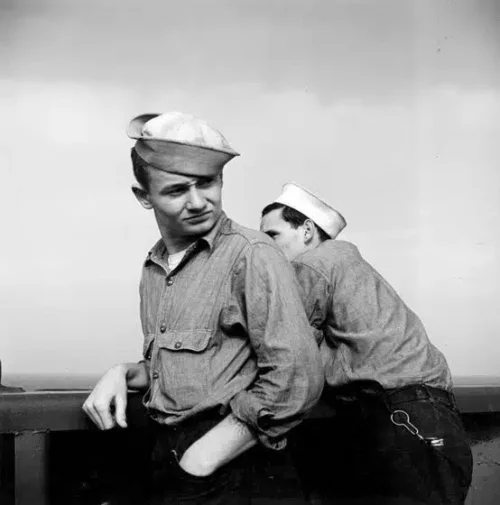
For the uninitiated, you’ll see the nomenclature of USN used by several brands to denote that their chambray shirt is styled in homage to those issued by the US Navy – who adopted the shirt as part of their uniform in 1901.
Over the decades, the Navy chambray shirts were quite varied – especially during WWII, when the number of manufacturers multiplied rapidly. However most of the reproduction USN shirts you’ll find today are patterned after models from the 1940s. And this is true of the Buzz Rickson model – which has a reputation for being one of the most faithful reproductions.
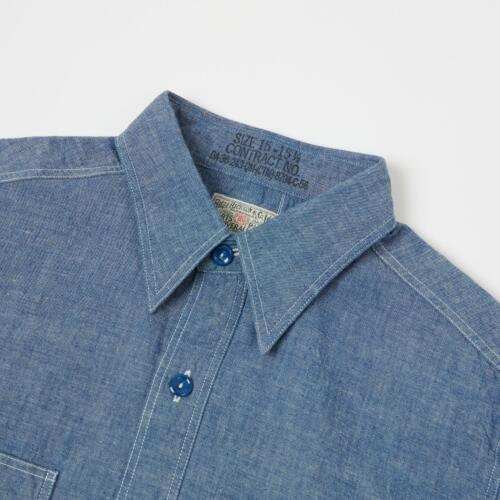
The cloth is a one-wash chambray woven on vintage shuttle looms and dyed to match the Navy’s exact colour specifications. The seams are reinforced with double-stitching. The inside of the collar even comes with a ‘contract label’ (above) which helped the Navy keep track of who made what, where and when.
The period-correct buttons are blue urea – urea-formaldehyde, a non-transparent thermosetting resin – which are altogether more durable than ordinary resin (polyester) buttons with increased resistance to abrasion, hot water washing (up to 120°C) and acid and alkali exposure.
The collar stand was one of the better reinforced amongst the reproduction shirts I tried. And so, I think readers should be able to pair this with more casual tailoring.
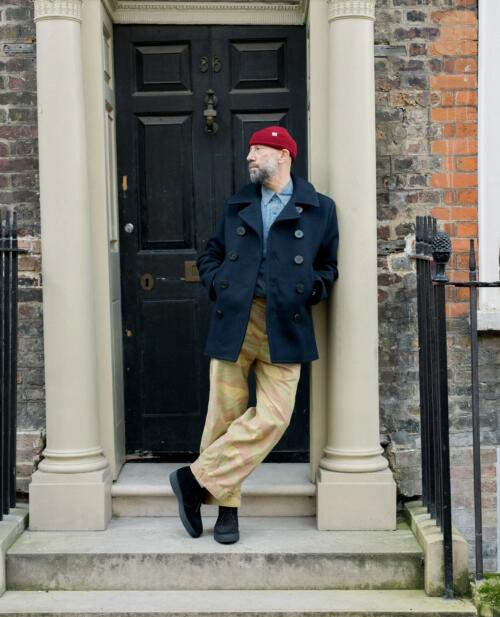
In terms of size, the 15-15.5” (medium) was almost tailor-made for me – to the point where I’d be nervous of it getting any smaller after a wash, but the Son of a Stag team were pretty confident that shrinkage would be minimal given it’s pre-washed.
That said, the sizing could still prove problematic for readers. The sleeve length finished smartly at my wrists, which, based on my experience of writing these guides, means it’s shorter than other shirts of comparable size. Similarly, the shirt length was noticeably less than most of the shirts in this guide – not an especially large concern for me as I tend to wear high-waisted trousers.
And so, I’d couch the fit as slightly small to size (which is not an uncommon characterisation for Japanese brands). If you’re long in the arms, the torso, or like lower-rise trousers you’ll likely either need to size up (I tried the 16-16.5” and the fit was decent, but, as you’d expect, quite full) or try a different brand. However, if the sizing works for you I think this is an excellent value option.
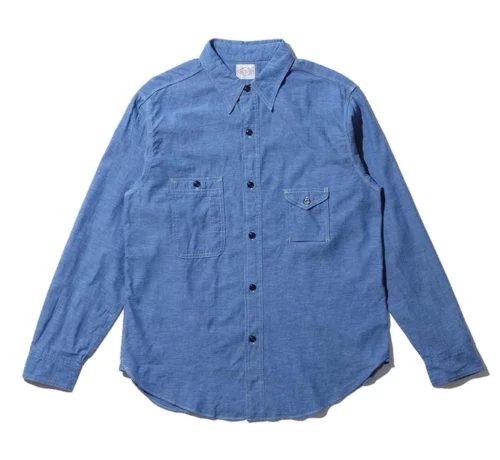
Big Yank 1935 Original Chambray Shirt Blue (£240)
Reliance Manufacturing Limited was a Chicago-based company formed in 1897. Its founding principles, considered to be disruptive at the time, were based on “the use of quality material and workmanship in clothes for the working man”. Sadly, the concept still feels almost revolutionary today.
Despite having a reputation for making shirts that were “clearly superior to the ugly uncomfortable shirts then being sold”, the Reliance name had little public recognition as most of their production was white-label.
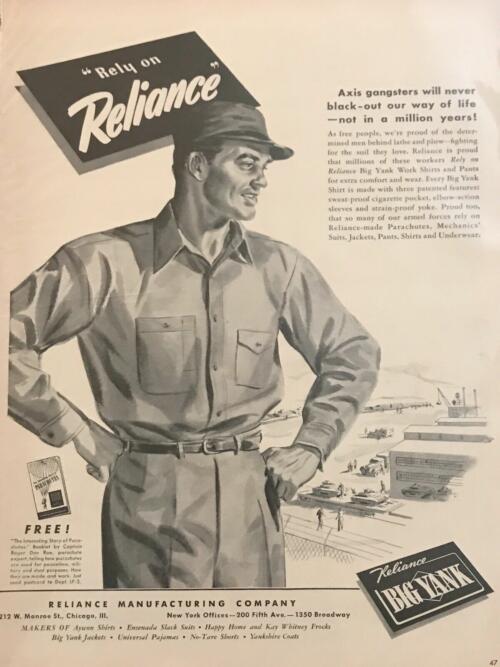
To rectify this, Reliance launched an in-house workwear brand called Big Yank in 1919, and advertising campaigns sought to position the new brand as synonymous with work clothing and the American way of life – as you can see in the advert above from 1942.
However, the main reason for the brand’s success and longevity was their appetite for pushing the envelope when it came to the design and functionality. A number of these design-elements are on display in the 1935 model I’ve chosen for this guide, which has been reproduced by 35ive Summers of Japan – who resurrected the Big Yank brand in 2011.
(They’re also responsible for bringing back other American stalwarts such as Rocky Mountain Featherbed – which returned in 2005).
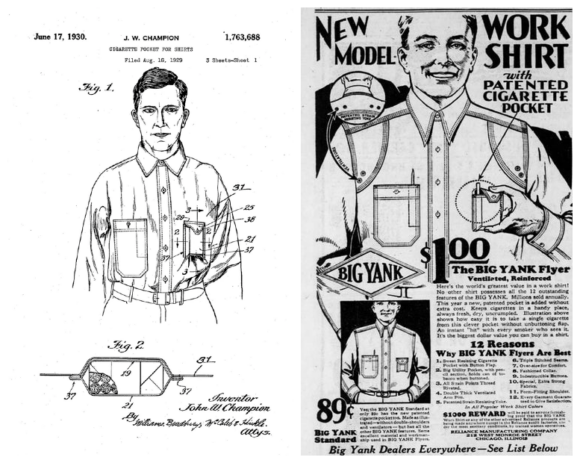
The most obvious and celebrated detail are the asymmetrical ‘convenience’ pockets. On the left breast, you’ll see the Gacha pocket (patented in 1930 – above left) which holds a packet of cigarettes and allows the wearer to extract a smoke without having to undo the button (above right).
In the 1930s, cigarette packets weren’t housed in plastic film and so were prone to becoming saturated by sweat in a standard single-fabric pocket. Inventor JW Champion’s patent application explains how his design eliminated this problem:
“My invention prevents this [saturation] by providing not only an additional ply of fabric rearwardly of the content of the pockets, but also providing an air space for ventilation between the rear wall of the pocket and the body of the shirt.”
The right breast holds an altogether larger utility pocket which (traditionally) accommodated a tobacco tin (these days it’s equally adept at stowing that other addictive product – the smartphone) and a compartment for a pen.
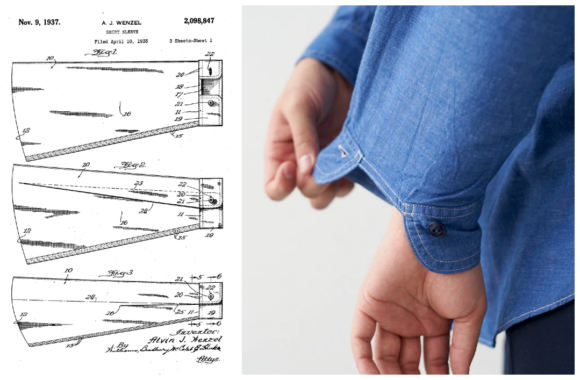
The other innovation you’ll find in the 1935 shirt is the “elbow action” sleeve and the “storm cuffs”. The above patent design highlights the key features: a wider sleeve panel that is finished with a cuff band that doesn’t run the full circumference of the sleeve opening.
What this design affords is increased freedom of movement through the arm and elbow and the ability to roll the sleeve high up the arm without restriction or discomfort.
The exclusion of a cuff placket and slit means there’s one less thing to catch and tear on machinery. And, when buttoning the reduced cuff band, more fabric naturally concertinas over the forearm which helps to prevent the elements from getting in.
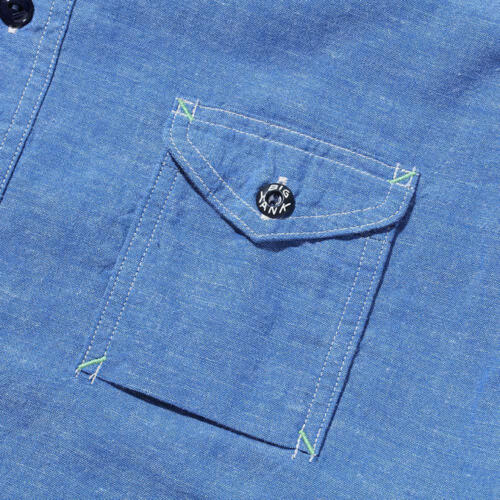
The earliest Big Yank shirts featured aluminium buttons, but by 1935 these had been almost completely replaced (save for a branded button on the Gacha pocket – above) by urea-resin buttons – presumably they were lighter and cheaper to produce than aluminium, without any noticeable compromise in performance.
In terms of construction, the shirt has bar tacks (above in green thread) and triple-needle stitching along the seams which help to reinforce key stress points.
By the way, anyone that’s interested in finding out more about the history of Big Yank should watch this video of 35ive Summers founder, Kinji Teramoto, talking through his archive of shirts.
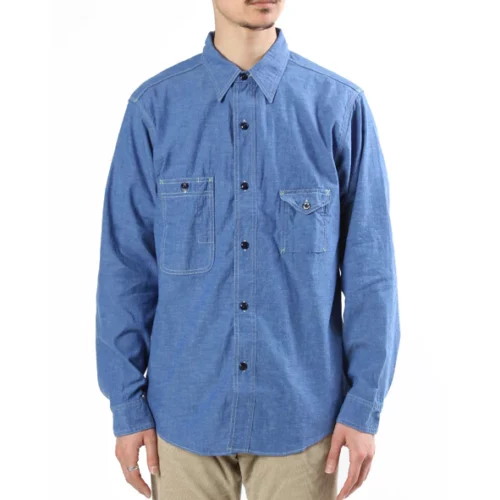
I tried the 1935 Big Yank shirt at Clutch Cafe in London in my regular size of 15.5” and it was a very good, relaxed fit. In anticipation of reader questions about keeping a slightly slimmer appearance I also tried the 15” and it was absolutely fine – comfortable to wear, no tightness and I could even do the collar up.
To my mind, sizing down does run slightly counter to the aesthetic of the shirt, but I wouldn’t discourage someone from going a half-size smaller if that suits their style better.
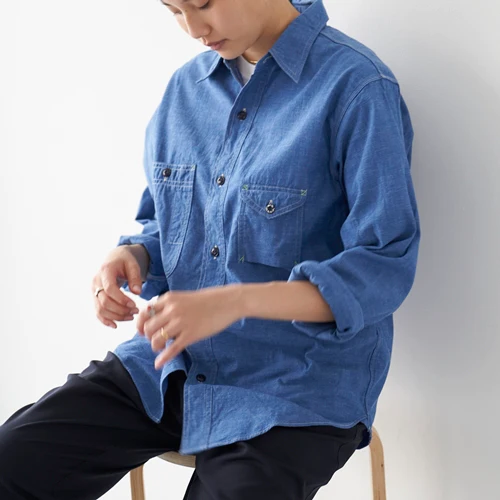
It only became apparent once the shirt was tucked in how much lower the chest pockets sit; here they’re in line with the third button on the placket, whereas most modern shirt pockets sit 1-2” higher – somewhere between the second and third button.
If you’re wearing especially high-waisted, pleated trousers the combination of that with the low-slung pockets might make your midriff appear a little busy and bulky, but, for everyone else, the chest pockets are more of a curio.
The colour of the shirt is stronger than the others in this guide, but I think it looked better in person and will hopefully fade out nicely. When I tried the shirt, I happened to be wearing a pair of navy worsted suit trousers – not the most natural of bedfellows for a chambray shirt, but a helpful reminder that one of the best ways to tame a brighter blue is with a darker one.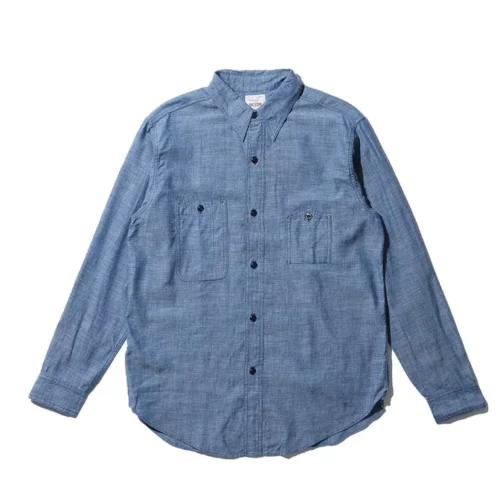
For those that want a crisper chambray in a slightly more muted colour, the 1942 Big Yank shirt (above) is a good choice and similar in most respects (including fit) to the 1935 shirt.
However, as it’s a wartime garment, some of the construction details have been pared back, so, for example, you won’t find the triple-needle stitching here. The cigarette pocket (a new design called the mountain pocket) is also, presumably, simpler to manufacture given it doesn’t have a flap.
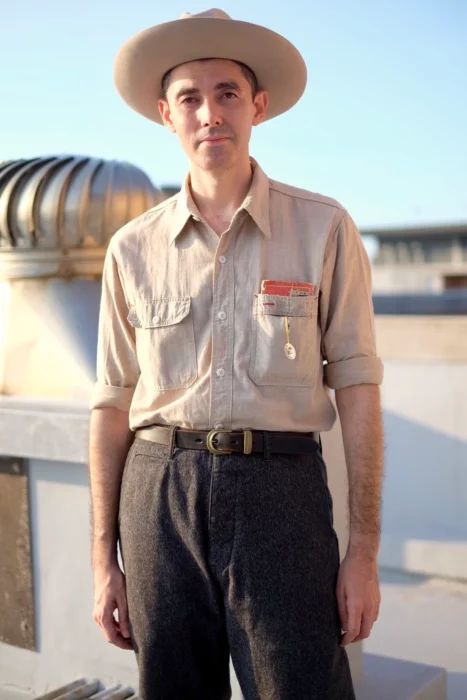
Honourable mentions
Bryan Shettig (above) founded The Rite Stuff with an aim of reproducing pre-WWII era workwear because, as he told UK stockist Those That Know, “as I continued to research […], I found that in terms of workwear clothing the high point was the 1920s and 1930s. […] The ‘40s and ‘50s were a period of maintaining, or slow decline, of the gains made in design and fabric quality leading up to the ‘20s and ‘30s”.
In writing this article, I spent a lot of time on Bryan’s website (and the associated blog) trawling through the considerable amount of research and archive material that he’s used to help him design his pieces. If anyone is interested in finding out more about the evolution of the American work shirt I’d highly recommend his two-part history.
Of The Rite Stuff’s chambray shirts, I really like the Uncle Sam in tan (above – it’s also available in blue) with its patented (naturally) E-Z Reach Double Cigarette pockets – they look really useful for those days when you want to travel light and keep your hands free. Uniquely, the shirt is finished with Corozo buttons, which were fairly common in the 1920s before being supplanted by Bakelite and plastic alternatives.

The Heracles work shirt (above) is another faithful reproduction of a 1920s/30s classic.
Whilst the number of heavy-duty design elements – the double-lined elbows and yoke, the ventilation holes, the extended chinstrap – might make the shirt less versatile for PS readers (who I suspect are just as likely to pair their chambrays with tailored flannel trousers as jeans) it’s an undeniably fascinating and expert construction.
Unfortunately, I wasn’t able to try any of The Rite Stuff’s shirts for this article, so I’d love to hear from readers that have experience of any of their products.
Manish is @the_daily_mirror on Instagram
Readers can find more information on chambray in the PS archives: The Guide to Denim and Chambray Shirtings
Next week: In part 2, our favourite modern, adapted chambray work shirts
